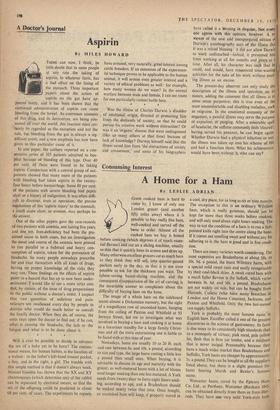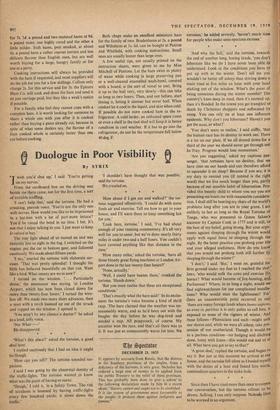Consuming Interest
A Home for a Ham
By LESLIE ADRIAN
,GOOD cooked ham is hard to come by. I know of only one London grocer (and another MY miles away) where it is possible to buy really fine ham, well-cooked and carved off the bone to order. Almost all the • cooked ham we buy is boned before cooking (which deprives it of much essen- tial flavour) 'and Cut on a sliding machine, usually so thin that it quickly loses its aroma and dries up. Many otherwise excellent grocers cut as much ham as they think they will sell, into quarter-pound packets early in the day, so that it is not even possible to ask for the thickness you want. The 10our-saving bacon-slicing machine, and the consequent disappearance of the art of carving, is the invariable answer to complaints about the difficulty of buying ham on the bone.
The image of a whole ham on the sideboard seems almost a Dickensian memory, but the sight of a magnificent row of uncooked hams, hanging from the ceiling of Paxton and Whitfield at 93 Jermyn Street, led me to investigate what was involved in buying a ham and cooking it at home as a luxurious standby for a large family Christ- mas and all the 'extra entertaining one is liable to be faced with at this time of year.
Nowadays, hams are usually 10 to 20 lb. each and cost between 6s.-and 10s. a pound, aCcording to size and type, the large hams costing a little less a pound than small ones. When buying, it is advisable to discuss its age and maturity with the grocer, as well-matured hams with a lot of bloom need longer soaking than one less matured. A York needs from twenty-four to forty-eight hours soak- ing, according to age, and a Bradenham should be soaked nearly twice that time. Once bought, an uncooked ham will keep, if properly stored in a cool, dry place, for as long as six or nine mor The exception to this is an ordinary Wilts ham, which is really gammon, should not kept for more than three weeks before cook and will only need about eight hours soaking. way to test the condition of a ham is to run a t pointed knife right into the centre along the b If it comes out smelling sweet and without an adhering to it, the ham is good and in fine co tion.
There are many varieties worth considering. most expensive are Bradenhams at about 10: 10s. 9d. a pound, the finest Wiltshire hams, a special mild sweet cure and easily recognisl by their coal-black skins. A sweet cured hams a much fuller flavour is the Suffolk, which va between 9s. 6d. and 10s. a pound. Bradenh, are not widely on sale, but can be bought fi Harrods, Cullens (who have many branchet London and the Home Counties), Jacksons, Paxton and Whitfield. Only the two last-oar can supply Suffolks.
York is probably the most famous name English ham. Escoffier called it one of the grea discoveries in the science of gastronomy. Its ft is due more to its consistently high standards t to a monopoly of virtues; pink meat, pale yel fat, flesh that is firm yet tender, and a mildr that is never insipid. Presumably because t have a much wider market than Bradenhams I Suffolks, York hams are cheaper by approximai Is. a pound.They can be bought at all the suppl listed above, but there is a slight premium hams bearing Marsh and Baxter's fam name.
Worcester hams, cured by the Epicure H Co. Ltd., at Pershore, Worcester (Pershore 11 can be obtained directly from them or from 11 rods. They have one very mild York-style 11 iths. hire be The one. fat ndi- The to with able with rics ams -om ; in and Tied in test 'me harl low less hey and tely iers for °us am D4), ar- air for 7s. 3d. a pound and two matured hams at 9d. a pound more, one highly cured and the other a little milder. Irish hams, peat smoked, at about Gs. a pound have a rather coarser texture and less delicate flavour than English ones, but are well worth buying for a large, hungry family or for use at a party.
Cooking instructions will always be provided with the ham if requested, and most suppliers will do the job for you for a few shillings. Culiens only charge 2s. for this service and for Ss. the Epicure Ham Co. will cook and dress the ham and send it In you carriage paid, but they like a week's notice if possible.
For a family who feel they cannot cope with a complete ham, it is worth looking for someone to share a whole one with you after it is cooked rather than buying a piece already cut, because in spite of what some dealers say, the flavour of a ham cooked whole is certainly better than one cut before cooking. Bath chaps make an excellent miniature ham for the family of two. Bradenhams at 2s. a pound and Wiltshires at Is. 6d. can be bought at Paxton and Whitfield, with cooking instructions. Small ones are usually leaner than large ones.
A few useful tips, not usually printed on the instruction sheets, were given to me by Miss Mitchell of Paxtons. Let the ham swim in plenty of water while cooking (a large preserving pan or a well-cleaned enamelled wash-bowl, covered with a board, is the sort of vessel to use). Bring it up to the boil very, very slowly—this can take as long as two hours. Then, and not before, start timing it, letting it simmer but never boil. When cooked let it cool in the liquid, and skin when cold. If possible do not store cooked ham in the re- frigerator. A cold larder, an unheated spare room or even a shelf in the tool shed will keep it in better condition in cool weather. If it has to go into the refrigerator, do not let the temperature fall below 40 deg. F.


























 Previous page
Previous page